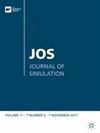基于微观离散事件的仿真在集散配送地点的城市物流系统建模中的应用
IF 1.7
4区 工程技术
Q4 COMPUTER SCIENCE, INTERDISCIPLINARY APPLICATIONS
引用次数: 0
摘要
摘要城市物流问题越来越受到人们的关注。在此范围内,我们的城市物流研究小组目前专注于城市集中的交付地点。在过去几年中开发了基于MS Excel和anylogic的仿真模型来分析它们,但是在这两种情况下,超过一定的模型尺寸仍然会遇到问题。出于这个原因,我们开始寻找一种灵活、快速、人人可用的新工具。选择使用Python编程语言,主要目标是消除以前的技术问题,并获得有关检查过程的详细信息。在本文中,我们将介绍以前的模型存在的问题,新的基于python的DES模型的开发、运行和主要优势,中试模型的设计和参数化,测试结果以及下一步的研究工作。关键词:城市物流购物中心仿真python labviewdes披露声明作者未报告潜在的利益冲突。本文章由计算机程序翻译,如有差异,请以英文原文为准。
Application of microscopic discrete event-based simulation in the modelling of the city logistics systems of concentrated sets of delivery locations
ABSTRACTNowadays, city logistics issues are getting more and more attention. Within this, our City Logistics Research Group is currently focusing on the urban concentrated sets of delivery locations. MS Excel- and AnyLogic-based simulation models were developed in the last years to analyze them, but still, problems were encountered above a certain model size in both cases. For this reason, we started looking for a new tool that is flexible, fast, and available for everyone. The use of Python Programming Language was selected, with the primary goal of eliminating the previous technical problems and obtaining detailed information about the examined processes. In this paper, we are going to present the problems of the previous models, the development, operation, and main advantages of the new, Python-based DES model, the design and parameterization of the pilot models, the results of the tests, and the next steps of the research.KEYWORDS: City logisticsshopping mallsimulationPythonLabVIEWDES Disclosure statementNo potential conflict of interest was reported by the author(s).
求助全文
通过发布文献求助,成功后即可免费获取论文全文。
去求助
来源期刊

Journal of Simulation
COMPUTER SCIENCE, INTERDISCIPLINARY APPLICATIONS-OPERATIONS RESEARCH & MANAGEMENT SCIENCE
CiteScore
5.70
自引率
16.00%
发文量
42
期刊介绍:
Journal of Simulation (JOS) aims to publish both articles and technical notes from researchers and practitioners active in the field of simulation. In JOS, the field of simulation includes the techniques, tools, methods and technologies of the application and the use of discrete-event simulation, agent-based modelling and system dynamics.
 求助内容:
求助内容: 应助结果提醒方式:
应助结果提醒方式:


